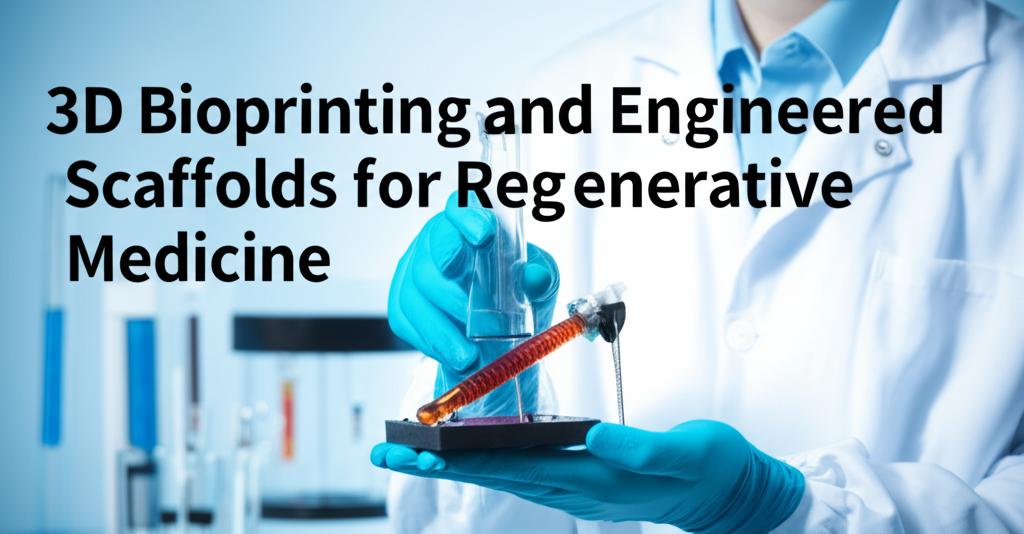3D bioprinting is a revolutionary technology transforming tissue engineering and regenerative medicine. It involves the layer-by-layer deposition of biomaterials, living cells, and bioactive molecules (collectively known as bioinks) to create complex, three-dimensional structures that mimic natural tissues and organs. This approach holds immense promise for repairing or replacing damaged tissues, potentially addressing organ shortages, and developing platforms for drug testing and disease modeling.
Engineered scaffolds are crucial components in this process. They act as temporary support structures that provide the necessary mechanical stability and microenvironment for cells to attach, grow, proliferate, and differentiate, ultimately forming functional tissue. Ideally, these scaffolds are biocompatible, biodegradable (degrading at a rate that matches new tissue formation), and possess appropriate porosity and mechanical properties similar to the target tissue.
3D bioprinting enables the precise fabrication of these scaffolds with intricate architectures tailored to specific patient needs, often derived from medical imaging data like CT or MRI scans. This customization is a significant advantage over traditional tissue engineering methods. Several 3D bioprinting techniques are employed:
- Extrusion-based Bioprinting: This is the most common method, where bioink is continuously dispensed through a nozzle using pneumatic or mechanical pressure. It allows for printing with relatively high cell densities but can sometimes pose challenges regarding cell viability due to shear stress and achieving very high resolution.
- Inkjet Bioprinting: This technique deposits droplets of bioink onto a substrate. It generally offers good cell viability but is often limited to low-viscosity bioinks.
- Stereolithography (SLA) and Light-based Techniques: These methods use light to selectively polymerize photosensitive bioinks layer by layer, offering high resolution but potentially limited by the need for transparent bioinks and specific material properties.
- Laser-Assisted Bioprinting (LAB): LAB uses laser energy to propel droplets of bioink, offering high precision and resolution without direct nozzle contact, minimizing shear stress.
The choice of biomaterials, or bioinks, is critical. Bioinks must be printable while also supporting cell survival and function. Common materials include:
- Natural Polymers: Materials like alginate, gelatin, collagen, hyaluronic acid, chitosan, and decellularized extracellular matrix (dECM) are favored for their excellent biocompatibility and ability to mimic the natural cellular environment. dECM, derived from tissues by removing native cells but preserving the matrix structure, is particularly promising as it retains tissue-specific cues.
- Synthetic Polymers: Polymers such as polycaprolactone (PCL), polyethylene glycol (PEG), and polylactic acid (PLA) offer tunable mechanical properties and degradation rates but may lack inherent bioactivity.
- Ceramics: Bioceramics like hydroxyapatite are often used in bone tissue engineering due to their osteoconductive properties.
- Composite Materials: Often, different materials are combined to create hybrid bioinks that leverage the advantages of each component, balancing printability, mechanical strength, and bioactivity.
Integrating cells with these scaffolds can occur through post-printing cell seeding or by embedding cells directly within the bioink during the printing process. The latter approach allows for precise spatial control over cell distribution within the construct.
Recent advancements have significantly pushed the field forward. Researchers are creating increasingly complex tissue structures for various applications, including:
- Bone and Cartilage Regeneration: 3D printed scaffolds, sometimes made from composites like PCL combined with hydrogels or bioactive ceramics, support bone and cartilage cell growth and differentiation, addressing defects or injuries.
- Skin Tissue Engineering: Bioprinting allows for the layered fabrication of skin substitutes containing relevant cell types, offering potential for wound healing and burn treatment.
- Cardiovascular Tissues: Efforts are focused on printing vascular grafts and patches of heart muscle tissue, tackling challenges like vascularization.
- Neural Tissues: Creating scaffolds that mimic the structure of neural tissue aims to support nerve regeneration and create models for neurological diseases.
- Organoids and Organ Models: Bioprinted models of organs like the liver are valuable tools for drug screening, toxicity testing, and studying disease progression.
Despite significant progress, several challenges remain. Achieving adequate vascularization within larger, complex printed tissues is a major hurdle, as cells need nutrients and oxygen. Ensuring long-term cell viability and function post-printing, optimizing the mechanical properties of scaffolds to match native tissues, and scaling up production for clinical use are ongoing areas of research. The development of standardized, reliable bioinks with consistent properties and overcoming regulatory hurdles for clinical translation are also critical.
The future of 3D bioprinting looks bright, with trends pointing towards multi-material printing to create more complex, heterogeneous tissues, the development of "smart" bioinks that respond to stimuli, and the integration of advanced technologies like AI for optimizing printing processes and scaffold design. Innovations like 4D bioprinting, where structures change shape or function over time post-printing, further expand the possibilities. Ultimately, 3D bioprinting combined with engineered scaffolds offers a powerful platform with the potential to revolutionize regenerative medicine, providing personalized solutions for tissue repair and organ replacement.

